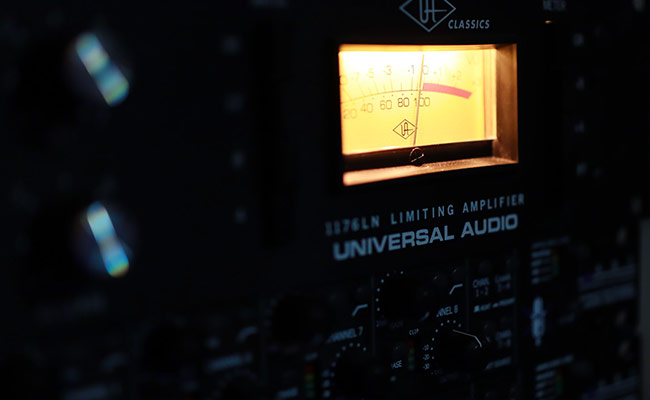When it comes to dance music genres, Hip Hop, and Rock music, most mastering engineers shoot for around -8 RMS, or LUFS, depending on their point of reference (there usually isn’t too much difference between the two measurements).
That being said, it really depends on the track and at what level it sounds best, which may be more like -10 LUFS, or even -12. Pop music is usually mastered anywhere between -8 and -12 LUFS.
While it’s true that streaming platforms have different loudness normalization standards that turn down the level for every dB that goes above their standardized level, you shouldn’t master to their exact requirements. For example, Spotify normalizes to -14 LUFS, but if you master to -14 you will find that your song sounds lower than other songs on such platforms.
Some music genres naturally lend themselves to quieter masters, such as acoustic music, ambient music, and orchestral music; the latter has to be approached very delicately so as to retain optimal dynamics.
The fact is, the majority of mastering engineers will be very reluctant to answer the question “how loud should a master be” because it depends on so many factors. And honestly, we shouldn’t be mastering to a one-size-fits-all loudness, though some genres are increasingly demanding this (see the loudness wars in some genres of dance music).
One sure thing mastering engineers will tell you is that the ability to create a loud master, and one that retains optimal dynamic range, is down to the loudness properties of the mix.
Let’s explore this topic further, so we can better understand loudness and where it really comes from in music.

How Loud Should I Master My Track?
The question of how loud a master should be has been a topic of discussion in the music industry for decades. But the reality is that there is no one-size-fits-all approach to achieving optimal loudness in mastering.
The loudness level should be tailored to fit the specific music you are working on. However, with the right combination of critical listening skills, practice, and knowledge of the key factors that influence loudness, you can consistently achieve the desired outcome.
Often, loudness is mistakenly viewed as a mere numerical value. However, in the realm of music, loudness is more about how we perceive sound with our ears and brain. Loudness is a sensation that occurs in our heads based on how music impacts us. Thus, assessing loudness is not a straightforward numerical value that exists in isolation.
For mastering engineers, understanding loudness in this context of human perception is crucial. It enables them to use creative techniques beyond simply pushing the limiter to achieve impactful, loud-sounding records.
Monitoring & Metering for Optimal Listening
Monitoring in mastering refers to listening to the audio signal through speakers or headphones to make critical decisions. Metering involves measuring various parameters such as loudness levels and dynamic range of the audio signal using specialized software tools.
Having accurate monitoring and metering is essential to the mastering process. Mastering decisions must be made consciously and effectively to serve the music, and this requires us to rely on the precision of our listening environment and metering tools.
The loudness we aim for must translate effectively into the marketplace and to the listeners’ ears. The tools we use must help us understand the overall sound, which includes frequency response, tonal balance, stereo imaging and loudness.
Effective metering, however, depends on our ability to make informed decisions through an optimal listening environment. Of course the acoustics of a room play a huge role in what we hear, and a mastering room needs to be appropriately treated. But it is also important to set listening standards when it comes to critical listening. For example, setting a fixed/calibrated level on our monitor controller allows us to understand the sound and how it will translate to the end-user.
Timbre & Loudness
Timbre, also known as tone color or quality, is the characteristic sound or “color” of a musical instrument, voice or sound source. It is the unique way in which different musical instruments or voices produce sound, and is determined by various factors such as the instrument’s shape, material and method of sound production, as well as the frequency, amplitude and duration of the sound waves produced.
Timbre plays a crucial role in the perception of loudness, with the sensitivity of our ears to different tone colors affecting how we experience sound.
Research like the Fletcher-Munson curves demonstrate that human ears are more sensitive to mid-range frequencies than low-end frequencies. While this knowledge can help maximize loudness in mastering, it’s important not to sacrifice too much of the low end and compromise the musical integrity.
Critical listening and thoughtfulness are crucial in finding the right balance. For instance, while a VU meter doesn’t account for perception, playing two tones at the same level and meter reading, one at 100 Hz and another at 2,000 Hz, reveals how much more clearly we hear the higher end of the spectrum. This indicates the importance of considering the tonal balance and the relationship between signals we’re more sensitive to and those we’re not in creating impactful, balanced masters.
Dynamic Contrast & Loudness
Dynamics in music refer to the variation in volume and intensity of sound in a piece, from soft to loud, and everything in between. It affects the emotional impact of music.
Dynamic contrast refers to the variation in volume and intensity between different sections or elements within a piece. It adds depth and emotion.
Dynamic contrast and its relationship to loudness is often overlooked. In mastering some engineers may instinctively apply compression to tighten the dynamics and boost the entire mix. However, sudden changes in dynamics can have a significant impact on the emotional impact of a production. In some cases, compressing a track may even compromise the natural build-up and climax of an epic piece.
To preserve these nuances, volume automation may be more effective during the mastering stage. When transitioning from a verse to a chorus, for example, the change in sound pressure level and loudness conveys a different emotion. The same principle can be applied to mixing.
A crucial aspect of producing great music is finding the right balance of dynamic range. Too much variation can be disruptive to the listener, while too little can detract from the message and artistic vision of the artist.
The Importance of Crest Factor
When it comes to your mix, it’s important to consider the crest factor, which measures the difference between the peak level and the average or RMS level.
A high crest factor can indicate that the transients in your mix are too prominent compared to the sustained elements. This may suggest that the mix has too much dynamic range and could benefit from careful transient control.
However, it’s important to note that the crest factor is context-dependent and should be evaluated in relation to the program material. For example, the crest factor of a snare drum hit that peaks at zero but is followed by sustained elements playing at around -14 dB RMS will be higher than that of an entire chorus. Understanding and managing the crest factor can help achieve a balanced and cohesive mix.
Loudness Perception
Loudness perception in music refers to the subjective experience of how loud a sound or music is perceived by an individual.
The perception of loudness is highly genre-dependent, as different genres have their own defining characteristics that affect loudness (such as sound design, crest factor, dynamic contrast and tonal balance).
For example, Hip Hop tracks are typically louder than Country records, but each genre has its own way of expressing dynamics. In classical music, dynamics are conveyed through variations in volume, whereas in dance music, dynamics are often expressed through changes in instrumentation and production techniques like filtering.
Achieving Loudness In Your Mix
It’s important to remember that achieving loudness in a record isn’t solely the mastering engineer’s responsibility. This is especially relevant if you’re a mixer or producer handling your own sessions.
There are several actions that can be taken before mastering that can contribute to the music’s loudness, from the initial stages of songwriting and arranging to the mixing stage.
For instance, incorporating the knowledge of dynamic contrasts into the songwriting and arrangement can be beneficial. Additionally, controlling crest factor during the mixing stage can be more effective than during mastering.
When you start mixing a track, it’s common to fall into the trap of gradually increasing the volume of individual elements to avoid them getting lost in the mix. However, this leads to a “creeping” mix, where there’s a noticeable difference in volume in certain elements as the track progresses. Such mixes can present a challenge during mastering, as there may be a big difference in volume between an element at the start of the track and at other points in the track.
It’s crucial to manage the gain staging during mixing, ensuring the balance between the primary elements like drums, bass and lead instruments is maintained throughout the journey of the track’s dynamics. This helps establish the intended dynamic journey of the track, allowing for an effective and sufficiently loud master.
A/B Comparison to Combat Loudness Bias
The purpose of conducting gain-matched A/B comparisons is to eliminate the influence of loudness bias and ensure that your decisions are not solely based on differences in sound pressure level. This is why you should always gain match when compressing an element of your mix; so that you can hear if the compression is beneficial vs being lured into a false sense of “better” by a change in gain.
This is also relevant in mastering, when comparing the initial mix file with the mastered file. If you’ve applied a 4dB gain in your limiter, it becomes challenging to determine whether your EQ adjustments are effective or not. Hence, it’s crucial to have an A/B metering setup that allows easy matching of the before-and-after versions.
Key Takeaways
Here’s a few key takeaways for you to remember:
- There is no one-size-fits all loudness standard for mastering, though genres do tend to develop their own ball-park standards that change with trends.
- Every genre requires a different mastering approach, as does every song.
- Perceived loudness can make a song seem louder than it is. Oftentimes I will compare two tracks and see that the one that sounds louder (perceived) is actually lower when I look at the metering. And this comes from the mix (see the next point).
- Loudness comes from the mix. The way dynamics are expressed is key. Consider crest factor and tonal balance, too. In addition, arrangement and production techniques as simple as volume automation and filtering can create loudness and impact in specific areas of a track.
- When mixing and mastering, always gain match compression and EQ changes to see if they truly are beneficial to the overall song.
- And finally, loud doesn’t mean better!

